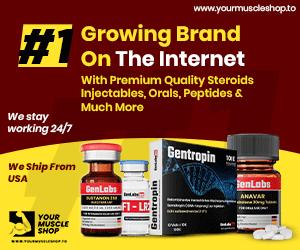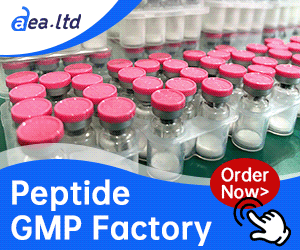- Joined
- Dec 16, 2011
- Messages
- 6,771
- Reaction score
- 1,902
- Points
- 198
Since their creation in the early 1930′s, steroids have been praised for their effectiveness by users, debated over their safety by medical professionals, outlawed by sport governing bodies, made illegal by governments and demonized by the press and public opinion. But despite steroids well-publicized, controversial history, few people really know a lot about what these substances are, how they work and how their use came to be a controversy in today’s sports.
Anabolic Androgenic Steroids are substances that cause muscles and other male hormonal traits to grow and develop beyond what the body would naturally develop on its own. The term anabolic refers to the buildup of tissue in cells. The term androgenic refers to producing male characteristics, such as large muscles, a deep voice and body hair.
Throughout history, many cultures have used a variety of substances they believed to make men stronger, more viral or even braver in battle. Rhinoceros horn, shark tooth and other various powders and extracts have all been thought to improve strength and ability. It was probably the study of some these ancient cultures use of animal testicles that led modern scientists to the discovery of steroids.
The first serious research into the creation of anabolic steroids began in the 1930s by German chemist Adolf Butenandt, who isolated the male hormone androstenone from thousands of liters of urine. Following the success of those early experiments with androstenone, several teams of scientists, backed by pharmaceutical companies, worked to synthesize the more powerful male hormone testosterone. By 1939, the world’s scientific community was already conducting human trials on the effects of injecting testosterone and the Nobel Prize that year was offered to Butenandt and another scientist, Leopold Ruzicka, for their work with testosterone. Unfortunately for Butenandt, the Nazis wouldn’t allow him to accept the honor.
During the 1940s and 1950s experiments with steroids continued and its use widened among athletes and body builders, especially in the Soviet Union and Eastern Bloc countries. The overwhelming domination by these countries in weightlifting events at the 1952 Olympics, prompted U.S. Olympic Team physician Dr. John Ziegler to begin issuing steroids to his athletes. Dr. Ziegler recruited the help of chemists to develop a compound that would achieve the same results for strength building as the Eastern Bloc countries steroids but with fewer side effects. The result was the first FDA approved steroid Dianabol, a.k.a Dbol.
Studies on the effects of Dianabol and other pharmaceutical anabolic steroid compounds for the next 30 years proved to be inconsistent and in some cases completely incompetent. While some studies would point to the dangerous side effects of steroid use, others would make it seem completely benign. One such study conducted in 1972 showed anabolic steroids as having little to no effect on the body because patients who were given a placebo showed no different results than those who were given real doses of steroids. The results of this study were widely cited as fact for almost two decades, despite the fact that the study only used low doses of steroids in people and had zero control over such aspects as diet, weight or health of the subjects involved.
By the 1960s and 1970s, steroid use by Olympic athletes prompted the ban of its use. A study by BYU faculty member and former world record holder for discus Jay Sylvester, showed that over 68 percent of the athletes at the 1972 Olympics were using or had used steroids. And in 1976, East Germany further created controversy with its women’s track and swim teams when it was discovered that their Wonder Girls (as they came to be known) were taking steroids given to them by their trainers who told them they were vitamins. The heavy use of steroids at these games created new rules and testing procedures for Olympic athletes. However, the testing often proved to be unreliable and athletes found avoiding detection of their steroid use easy.
At the same time steroid use was being condemned by the Olympics, other sports figures and even movie stars were making its use popular. The growing body building industry, fueled by Hollywood images like Arnold Schwarzeneger’s Conan the Barbarian made the muscled look hip and steroids became widely sought after by amateur athletes for the first time.
In professional sports, steroid use was also on the rise, especially in football where size and strength are essential to a player’s effectiveness. But just as in Olympic sports, the backlash to steroid use in professional sports prompted organizations lie the NFL and NBA to adopt anti-steroid rules and screening for players to try and keep their use out of those sports.
In 1991, the government stepped in and made steroids a Schedule III controlled substance, making their non-prescribed possession and distribution illegal and punishable by fines and prison terms. Public backlash to steroid use continued to grow throughout the 1990s, fueled by reports of doping scandals in America’s Pastime Major League Baseball. As reports of baseball’s biggest stars using steroids came to light in the press, the world learned more and more about steroid use and its many new forms.
Today, steroids have taken on new forms. No longer known as just roids, Arnolds, pumpers, stackers and juice the street names of yesterday’s DBol and other testosterone-based substances today’s steroids have taken on more sophisticated titles like performance enhancers and human growth hormone. As more science is put into the creation of these new compounds, testing to make sure professional athletes aren’t juiced has become more and more problematic.
Because steroids are effective in what they do, it may be an uphill battle for sports and society in general to fully regulate and stop their use. The more people are educated on the risks and proper use, however, the safer their use of steroids will become.
Isolation of gonadal AAS
Chemical structure of the natural anabolic hormone testosterone, 17β-hydroxy-4-androsten-3-oneThe use of gonadal steroids pre-dates their identification and isolation. Medical use of testicle extract began in the late 19th century while its effects on strength were still being studied.[5] The isolation of gonadal steroids can be traced back to 1931 when Adolf Butenandt, a chemist in Marburg, purified 15 milligrams of the male hormone androstenone from tens of thousands of litres of urine. This steroid was subsequently synthesized in 1934 by Leopold Ruzicka, a chemist in Zurich.[6]
In the 1930s it was already known that the testes contained a more powerful androgen than androstenone, and three groups of scientists, funded by competing pharmaceutical companies in the Netherlands, Nazi Germany and Switzerland, raced to isolate it.[6][7] This hormone was first identified by Karoly Gyula David, E. Dingemanse, J. Freud and Ernst Laqueur in a May 1935 paper "On Crystalline Male Hormone from Testicles (Testosterone)."[8] They named the hormone testosterone, from the stems of testicle and sterol, and the suffix of ketone. The chemical synthesis of testosterone was achieved in August that year, when Butenandt and G. Hanisch published a paper describing "A Method for Preparing Testosterone from Cholesterol."[9] Only a week later, the third group, Ruzicka and A. Wettstein, announced a patent application in a paper "On the Artificial Preparation of the Testicular Hormone Testosterone (Androsten-3-one-17-ol)."[10] Ruzicka and Butenandt were offered the 1939 Nobel Prize in Chemistry for their work, but the Nazi government forced Butenandt to decline the honor, although he accepted the prize after the end of World War II.[6][7]
Clinical trials on humans, involving either oral doses of methyltestosterone or injections of testosterone propionate, began as early as 1937.[6] Testosterone propionate is mentioned in a letter to the editor of Strength and Health magazine in 1938; this is the earliest known reference to an anabolic steroid in a U.S. weightlifting or bodybuilding magazine.[6] There are often reported rumors that German soldiers were administered anabolic steroids during the Second World War, the aim being to increase their aggression and stamina, but these are, as yet, unproven.[11] Adolf Hitler himself, according to his physician, was injected with testosterone derivatives to treat various ailments.[12] AAS were used in experiments conducted by the Nazis on concentration camp inmates,[12] and later by the allies attempting to treat the malnourished victims that survived Nazi camps.
Anabolic Androgenic Steroids are substances that cause muscles and other male hormonal traits to grow and develop beyond what the body would naturally develop on its own. The term anabolic refers to the buildup of tissue in cells. The term androgenic refers to producing male characteristics, such as large muscles, a deep voice and body hair.
Throughout history, many cultures have used a variety of substances they believed to make men stronger, more viral or even braver in battle. Rhinoceros horn, shark tooth and other various powders and extracts have all been thought to improve strength and ability. It was probably the study of some these ancient cultures use of animal testicles that led modern scientists to the discovery of steroids.
The first serious research into the creation of anabolic steroids began in the 1930s by German chemist Adolf Butenandt, who isolated the male hormone androstenone from thousands of liters of urine. Following the success of those early experiments with androstenone, several teams of scientists, backed by pharmaceutical companies, worked to synthesize the more powerful male hormone testosterone. By 1939, the world’s scientific community was already conducting human trials on the effects of injecting testosterone and the Nobel Prize that year was offered to Butenandt and another scientist, Leopold Ruzicka, for their work with testosterone. Unfortunately for Butenandt, the Nazis wouldn’t allow him to accept the honor.
During the 1940s and 1950s experiments with steroids continued and its use widened among athletes and body builders, especially in the Soviet Union and Eastern Bloc countries. The overwhelming domination by these countries in weightlifting events at the 1952 Olympics, prompted U.S. Olympic Team physician Dr. John Ziegler to begin issuing steroids to his athletes. Dr. Ziegler recruited the help of chemists to develop a compound that would achieve the same results for strength building as the Eastern Bloc countries steroids but with fewer side effects. The result was the first FDA approved steroid Dianabol, a.k.a Dbol.
Studies on the effects of Dianabol and other pharmaceutical anabolic steroid compounds for the next 30 years proved to be inconsistent and in some cases completely incompetent. While some studies would point to the dangerous side effects of steroid use, others would make it seem completely benign. One such study conducted in 1972 showed anabolic steroids as having little to no effect on the body because patients who were given a placebo showed no different results than those who were given real doses of steroids. The results of this study were widely cited as fact for almost two decades, despite the fact that the study only used low doses of steroids in people and had zero control over such aspects as diet, weight or health of the subjects involved.
By the 1960s and 1970s, steroid use by Olympic athletes prompted the ban of its use. A study by BYU faculty member and former world record holder for discus Jay Sylvester, showed that over 68 percent of the athletes at the 1972 Olympics were using or had used steroids. And in 1976, East Germany further created controversy with its women’s track and swim teams when it was discovered that their Wonder Girls (as they came to be known) were taking steroids given to them by their trainers who told them they were vitamins. The heavy use of steroids at these games created new rules and testing procedures for Olympic athletes. However, the testing often proved to be unreliable and athletes found avoiding detection of their steroid use easy.
At the same time steroid use was being condemned by the Olympics, other sports figures and even movie stars were making its use popular. The growing body building industry, fueled by Hollywood images like Arnold Schwarzeneger’s Conan the Barbarian made the muscled look hip and steroids became widely sought after by amateur athletes for the first time.
In professional sports, steroid use was also on the rise, especially in football where size and strength are essential to a player’s effectiveness. But just as in Olympic sports, the backlash to steroid use in professional sports prompted organizations lie the NFL and NBA to adopt anti-steroid rules and screening for players to try and keep their use out of those sports.
In 1991, the government stepped in and made steroids a Schedule III controlled substance, making their non-prescribed possession and distribution illegal and punishable by fines and prison terms. Public backlash to steroid use continued to grow throughout the 1990s, fueled by reports of doping scandals in America’s Pastime Major League Baseball. As reports of baseball’s biggest stars using steroids came to light in the press, the world learned more and more about steroid use and its many new forms.
Today, steroids have taken on new forms. No longer known as just roids, Arnolds, pumpers, stackers and juice the street names of yesterday’s DBol and other testosterone-based substances today’s steroids have taken on more sophisticated titles like performance enhancers and human growth hormone. As more science is put into the creation of these new compounds, testing to make sure professional athletes aren’t juiced has become more and more problematic.
Because steroids are effective in what they do, it may be an uphill battle for sports and society in general to fully regulate and stop their use. The more people are educated on the risks and proper use, however, the safer their use of steroids will become.
Isolation of gonadal AAS
Chemical structure of the natural anabolic hormone testosterone, 17β-hydroxy-4-androsten-3-oneThe use of gonadal steroids pre-dates their identification and isolation. Medical use of testicle extract began in the late 19th century while its effects on strength were still being studied.[5] The isolation of gonadal steroids can be traced back to 1931 when Adolf Butenandt, a chemist in Marburg, purified 15 milligrams of the male hormone androstenone from tens of thousands of litres of urine. This steroid was subsequently synthesized in 1934 by Leopold Ruzicka, a chemist in Zurich.[6]
In the 1930s it was already known that the testes contained a more powerful androgen than androstenone, and three groups of scientists, funded by competing pharmaceutical companies in the Netherlands, Nazi Germany and Switzerland, raced to isolate it.[6][7] This hormone was first identified by Karoly Gyula David, E. Dingemanse, J. Freud and Ernst Laqueur in a May 1935 paper "On Crystalline Male Hormone from Testicles (Testosterone)."[8] They named the hormone testosterone, from the stems of testicle and sterol, and the suffix of ketone. The chemical synthesis of testosterone was achieved in August that year, when Butenandt and G. Hanisch published a paper describing "A Method for Preparing Testosterone from Cholesterol."[9] Only a week later, the third group, Ruzicka and A. Wettstein, announced a patent application in a paper "On the Artificial Preparation of the Testicular Hormone Testosterone (Androsten-3-one-17-ol)."[10] Ruzicka and Butenandt were offered the 1939 Nobel Prize in Chemistry for their work, but the Nazi government forced Butenandt to decline the honor, although he accepted the prize after the end of World War II.[6][7]
Clinical trials on humans, involving either oral doses of methyltestosterone or injections of testosterone propionate, began as early as 1937.[6] Testosterone propionate is mentioned in a letter to the editor of Strength and Health magazine in 1938; this is the earliest known reference to an anabolic steroid in a U.S. weightlifting or bodybuilding magazine.[6] There are often reported rumors that German soldiers were administered anabolic steroids during the Second World War, the aim being to increase their aggression and stamina, but these are, as yet, unproven.[11] Adolf Hitler himself, according to his physician, was injected with testosterone derivatives to treat various ailments.[12] AAS were used in experiments conducted by the Nazis on concentration camp inmates,[12] and later by the allies attempting to treat the malnourished victims that survived Nazi camps.










